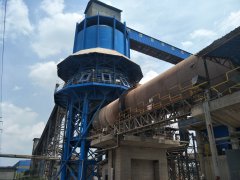The Ceramic Pellet Rotary Kiln is a critical apparatus utilized in the production of ceramic pellets, playing a central role in the thermal processing of raw materials to create durable and versatile ceramic products. Also known as a ceramic pellet rotary calciner, this kiln is fundamental in shaping and firing ceramic granules to achieve the desired physical and chemical properties.
Design and Structure:
The ceramic pellet rotary kiln typically consists of a rotating cylindrical drum, inclined at a slight angle to the horizontal, and is lined with refractory materials to withstand high temperatures. The design allows for the continuous movement of ceramic pellets through the kiln during the thermal treatment process.
Pellet Formation:
The process begins with the preparation of raw materials, including clay, kaolin, feldspar, and other ceramic components. These materials are blended to create a homogeneous mixture, which is then shaped into small granules or pellets. These ceramic pellets, with their specific composition, serve as the feedstock for the rotary kiln.
Thermal Processing:
As the ceramic pellets move through the rotary kiln, they are subjected to controlled high temperatures. This thermal treatment initiates a series of complex reactions, including the elimination of water and organic substances, as well as the sintering of ceramic particles. Sintering results in the densification and strengthening of the pellets, imparting the desired structural integrity to the final ceramic product.
Applications:
Ceramic pellets produced in rotary kilns are employed in a wide range of applications. In the construction industry, they serve as essential components in the production of ceramic tiles, bricks, and structural ceramics. In the field of advanced ceramics, these pellets are utilized in manufacturing cutting-edge products such as high-performance ceramics, catalysts, and electronic components.
Quality Control:
The efficiency and success of the ceramic pellet rotary kiln are closely tied to precise control of factors such as temperature, residence time, and atmosphere within the kiln. These parameters are critical for achieving the desired physical and chemical properties in the final ceramic product.
Conclusion:
In summary, the Ceramic Pellet Rotary Kiln is a vital piece of equipment in the ceramic industry, facilitating the controlled thermal processing of raw materials to produce high-quality ceramic pellets. Its role extends across various sectors, contributing to the creation of diverse ceramic products that form the backbone of construction, technology, and industrial applications. Ongoing advancements in kiln technology aim to enhance efficiency, sustainability, and product quality in ceramic pellet production.


